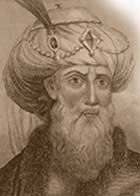Ancient Israel
 Jewish Wars, Then and Now
Jewish Wars, Then and NowMonday, January 11, 2010 | Jewish Ideas Daily » Daily Features
A masterwork of historical writing, The Jewish Wars by Yosef ben Matityahu, better known by his Roman name of Flavius Josephus (37–ca. 100 C.E.) is a massive and indispensable chronicle of Jewish fortunes from the Hasmonean Revolt in the second century B.C.E. through the destruction of the Temple and the fall of Masada in 73 C.E. It is also the autobiography of an extraordinary and extraordinarily conflicted man. Military leader, historian, biblical interpreter, negotiator, diplomat, neither martyr nor traitor but something in-between, Josephus traversed a route from battlefield commander in the war against Rome to Roman citizen and favored beneficiary of imperial...
 Temple & Synagogue
Temple & SynagogueWednesday, December 16, 2009 | Jewish Ideas Daily » Daily Features
The structure defiled by the pagan Greeks in the rabbinic story of the miracle of Hanukkah was a replacement building for the First (Solomon’s) Temple, destroyed by the Babylonians in 586 B.C.E. The replacement was itself replaced by the magnificent Second Temple, completed by King Herod around 20 B.C.E. and in turn destroyed by the Romans 90 years later. By then, the centralized model of Temple worship with its sacrifices had already begun to be supplanted by prayer worship in small synagogues both inside and outside the Holy Land. Although the precise architecture of Solomon’s Temple can only be guessed at,...
Editors' Picks
Myrtle, Date Palm, Willow, Citron Arthur Schaffer, Tradition. What do the "four species" of Sukkot signify? A botanist finds an agricultural interpretation that would have been readily available to an ancient Israelite farmer. (PDF, 1982)
The Fast of Fasts Philologos, Forward. In rabbinic times, when a Jew spoke of "the fast," there was no need to be more specific—as even a passage in the New Testament interestingly attests.
Flogging and the Rabbis Michael L. Satlow, Michael L. Satlow. A once-common practice, recently recommended for revival by an American criminologist, is discussed at length in the Talmud. Barbarous, or something more complex and perhaps even effective?
On the Ninth of Av Frank Talmage, Commentary. In Catalonia, Spain, once the scene of centuries of Jewish hopes and achievement, a student of Jewish history is beset by a torrent of emotions.
From Jerusalem's Ancient Tunnels Associated Press.
On the eve of Tisha b'Av, archaeologists revealed artifacts newly unearthed from the great Jewish revolt against Rome (67–70 C.E.), including coins minted by the rebels and a stone incised with a sketch of the Temple menorah.
Pooling Genes Gianna Palmer, Forward.
A new scientific paper uses DNA to assert a genetic link between Jews and Africans—a link also attested by ancient Jewish tales of trade and other exchanges with sub-Saharan Africa.
Me and Jonah Harold Bloom, New York Review of Books.
My favorite book of the Bible is a sly masterpiece, a parody of prophetic solemnities, a magnificent piece of literature because it is so funny.
For Whom the Bell Tolls Associated Press. Did a tiny ancient golden bell, found near the Temple Mount and making a faint metallic clink, once adorn a priestly garment?
Cantors and Levites Jonathan L. Friedmann, Daily Rabbi. Five years of formal schooling may seem like a lot, but as with the Levites in the ancient Temple, the musical and Jewish training of today's cantors is a lifetime's affair.
Sabbath Rock BibleWalks. Newly discovered: carved into a rock in Lower Galilee is the word shabbat, likely a Roman-era marking of the furthest point to which local Jews could travel on the day of rest.

